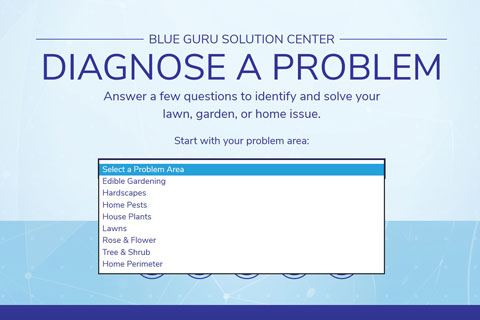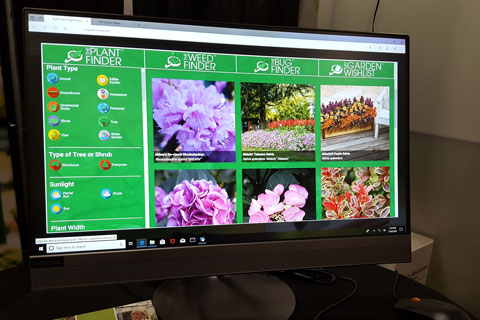4/1/2020
What’s Your Problem?
Jennifer Polanz
It’s a common occurrence at the garden center: a customer comes in with a picture on their phone, or even a baggy of leaves or a stem, and asks, “What’s wrong with this? or “What the heck is this?”
Independent retailers have long been a source of information for customers and this area is one where resourceful employees shine, even if they aren’t educated experts. They may not know the answer right away, but if they have the resources to find the answer, they’re that much closer to a sale of a bottle of copper fungicide or 3-in-1 pest control spray and a relieved customer.
Of course, there’s the tried-and-true method of a library of books that feature disease and pest information, but that can often be cumbersome and time consuming (although a great backup). But today, staff members and customers have a wealth of knowledge at their fingertips if they look in the right places. Here are just a few options.

Go to the Source
Manufacturers often have identification guides for retailers in a variety of forms, as well as documentation about what insects and diseases their products are effective against. SBM Life Science is no exception, with the Blue Guru Solution Center on the website of its garden products brand BioAdvanced. If you visit www.bioadvanced.com and scroll to the bottom of the page, you can choose from a drop-down menu of options, like Edible Gardening, Rose & Flower, House Plants and many more. It’ll offer symptoms, possible causes and then solutions, including product recommendations.
The site is also mobile optimized, so it can be used on any device and there’s a chat function as well where customers could ask for more specific advice. If staff members have access to devices on the sales floor, it’s one tool they could use when offering solutions to customers.
In Store & At Home
We recently received word about the merging of two companies via an acquisition that could help customers with identification at home and in the garden center. The company Smart Plant Home, which started as an app to help consumers identify their plants and take care of them, purchased The Perfect Plant (an in-store kiosk and online resource) in January as a way to extend its reach.
Now consumers and retailers can have a multi-pronged approach to pest and disease identification. If a customer has a question at home, they can log on to their Smart Plant Home app, upload a photo and chat with an expert to get their question answered, says CEO Bert Wahlen. Smart Plant Home has licenses with retail garden centers, currently about 115, and those online experts direct consumers to nearby retailers for their solution or give them the option of ordering online and picking up at the retailer. Products are shipped via a partnership with Home & Garden Fulfillment, which has a network of 20 plant and hardgoods fulfillment locations.
If the garden center is licensed with Smart Plant Home, they also can have the identification integrated into their website and at a kiosk in their stores. This is the Perfect Plant portion that Bert purchased (Perfect Plant founder Ken Klopp is now President of Smart Plant Home) and features options for a Weed Finder, Bug Finder and Disease Finder, along with a Plant Finder. Once a customer or staff member clicks on the problem, a solution is offered based on what’s in stock. All of the options are optimized toward the geographic area and availability. You can see an example of the system on the Wallace’s Garden Center website at www.wallacesgardencenter.com. Once at the site, click on Plant Finder.
 Pictured: Ken Klopp gave us a demo of the Perfect Plant online component at Cultivate’18. Now there’s a Disease Finder segment, as well.
Pictured: Ken Klopp gave us a demo of the Perfect Plant online component at Cultivate’18. Now there’s a Disease Finder segment, as well.
Universities & Government Agencies
Of course, there are a few more options in searching out help, particularly for those pesky unusual issues that don’t seem to present quite like they should. While funding for extension has been spotty lately, many states still have extension offices that can be contacted for information like this, particularly on pest and disease issues. I found a handy clearinghouse for all this information at the National Pesticide Information Center, which has a link to search all cooperative extension resources. You can find that at npic.orst.edu/pest/countyext.htm.
It also pays to stay on top of the most recent pests and diseases that are affecting ornamental and horticulture crops. You can find a wide range of details about pests at the USDA’s Animal & Plant Health Inspection Service website, including up-to-date tracking on pests like Spotted Lanternfly and Emerald Ash Borer, among others. Visit the website here: www.aphis.usda.gov/aphis/resources/pests-diseases/pests-and-diseases.
This is by no means a comprehensive list, and there are likely to be more cropping up even in the near future, but these are a start to providing the solutions customers need to feel good about their gardens and landscapes. GP